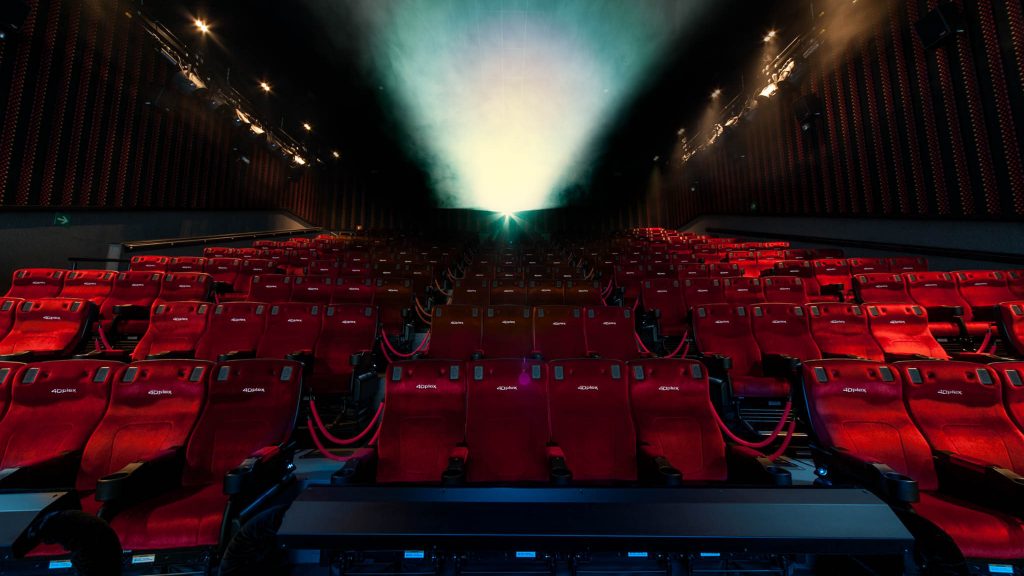Why Movie Theaters Have Red Seats

Find someone around you who hasn’t read the title of today’s email. Ask them what color the seats are in a movie theater. Chances are, they’ll say “red.” Google Image Search results for “movie theater” and “movie theater seats” will give you similar results; while not all of the chairs are red, most are, including images used by NPR (seen above), the Los Angeles Times, New York magazine, CNN, USA Today, Forbes, and many others. The reason for this is not a coincidence and it’s not a conspiracy.
It’s science.
Our eyes have two different parts that help us detect the presence of light — we have “rods” and “cones.” As Gizmodo summarizes, “[r]ods, which are the more numerous, are more light sensitive in general, but have no receptivity to color. Cones, on the other hand, are few and weak, but brings the color into life.” While these two parts have independent functions, they work in conjunction with one another. In a brightly-lit environment, the rods don’t need to do all that much and the cones get to do more — imagine the visual cornucopia provided by a sunny afternoon in the spring. But when there isn’t as much light, the opposite happens; as Gizmodo notes, “the cones lose their grip on our vision and the rods take over.” Instead of our rains focusing on the rainbow of colors around us, it focuses our attention on finding light. Safety first, after all.
But when it comes to color, not all light is the same. Red light has a longer wavelength than orange light, orange has a longer wavelength than yellow, and so on and so forth all the way to blue, then indigo, and then violet. When our rods take over in low-light situations, the cones are still working, just not quite as hard. It’s easier for them to detect shorter wavelengths, so red is the first color we lose the ability to discern. This is called the Purkinje effect, named after a Czech anatomist who first articulated the phenomenon back in 1819.
The Purkinje effect is hard to imagine in the abstract, and most of us aren’t sitting in a movie theater waiting for the lights to dim. That’s OK — Wikipedia can help. Here’s an animated gif simulating the effect:

As you can see (if you’re not red/green colorblind, and if you are, please take my word for it), in a full-light situation, the red flower of the geranium pops out from the green background. But when the light dims, the flower quickly fades from a vibrant red to a much duller, darker shade. The greenery behind it, while also losing its vibrance, does so less quickly, arguably becoming more noticeable than the previously-dominant red flower. As even more light leaves, the entire scene becomes black and white.
The experience inside a movie theater operates the same way. As the lights dim in the theater, the seats — and the walls and curtains, which are also often red — quickly fade into darkness. That helps our eyes focus their attention on the screen, making the movie-viewing experience more enjoyable.
Again, not all theaters use red seats — black ones will also work nicely. But you’ll rarely if ever, see green or blue seats in theaters; those colors simply take too long to fade away, and would distract from the viewing experience.
Bonus fact: When you go to the movies, the theater often has a quick little film that instructs you to silence your phone and, generally, be quiet as to not interfere with the viewing experience of your fellow theatergoers. And that’s probably why you rarely see parents bring babies to movie theaters; that’d be a really rude thing to do, as babies cry a lot. But that wasn’t always the case. Decades ago, to accommodate their customers who happened to have welcome a new child into the world, many movie theaters had “cry rooms” attached to the main theater. These rooms were soundproofed booths that had a view of the screen and piped in audio; parents and their littles ones could retreat to the room if need be, sparing the other customers the wails of the unconsolable child. The accommodation has all but disappeared, though.
From the Archives: How Popcorn Became a Movie Theater Thing: It’s loud, it’s messy, and… we love it. But how’d movie theater popcorn get its start?
